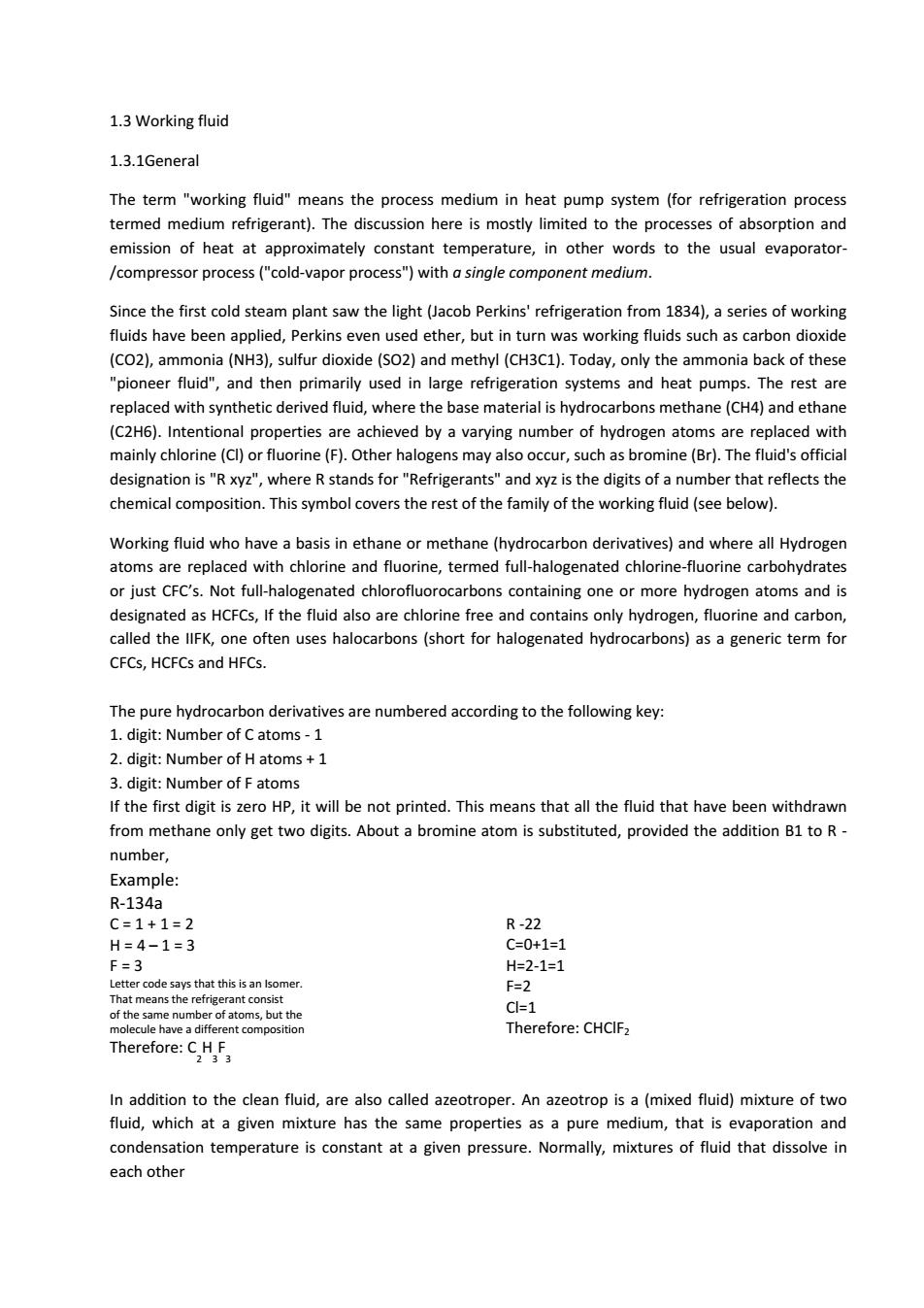正在加载图片...

1.3 Working fluid 1.3.1General The term "working fluid"means the process medium in heat pump system (for refrigeration process termed medium refrigerant).The discussion here is mostly limited to the processes of absorption and emission of heat at approximately constant temperature,in other words to the usual evaporator- /compressor process("cold-vapor process")with a single component medium. Since the first cold steam plant saw the light (Jacob Perkins'refrigeration from 1834),a series of working fluids have been applied,Perkins even used ether,but in turn was working fluids such as carbon dioxide (CO2),ammonia(NH3),sulfur dioxide(SO2)and methyl(CH3C1).Today,only the ammonia back of these "pioneer fluid",and then primarily used in large refrigeration systems and heat pumps.The rest are replaced with synthetic derived fluid,where the base material is hydrocarbons methane(CH4)and ethane (C2H6).Intentional properties are achieved by a varying number of hydrogen atoms are replaced with mainly chlorine(Cl)or fluorine(F).Other halogens may also occur,such as bromine(Br).The fluid's official designation is "R xyz",where R stands for"Refrigerants"and xyz is the digits of a number that reflects the chemical composition.This symbol covers the rest of the family of the working fluid(see below). Working fluid who have a basis in ethane or methane(hydrocarbon derivatives)and where all Hydrogen atoms are replaced with chlorine and fluorine,termed full-halogenated chlorine-fluorine carbohydrates or just CFC's.Not full-halogenated chlorofluorocarbons containing one or more hydrogen atoms and is designated as HCFCs,If the fluid also are chlorine free and contains only hydrogen,fluorine and carbon, called the llFK,one often uses halocarbons (short for halogenated hydrocarbons)as a generic term for CFCs,HCFCs and HFCs. The pure hydrocarbon derivatives are numbered according to the following key: 1.digit:Number of C atoms-1 2.digit:Number of H atoms +1 3.digit:Number of F atoms If the first digit is zero HP,it will be not printed.This means that all the fluid that have been withdrawn from methane only get two digits.About a bromine atom is substituted,provided the addition B1 to R- number, Example: R-134a C=1+1=2 R-22 H=4-1=3 C=0+1=1 F=3 H=2-1=1 Letter code says that this is an Isomer F=2 That means the refrigerant consist of the same number of atoms,but the CI=1 molecule have a different composition Therefore:CHCIF2 Therefore:C H F 233 In addition to the clean fluid,are also called azeotroper.An azeotrop is a(mixed fluid)mixture of two fluid,which at a given mixture has the same properties as a pure medium,that is evaporation and condensation temperature is constant at a given pressure.Normally,mixtures of fluid that dissolve in each other1.3 Working fluid 1.3.1General The term "working fluid" means the process medium in heat pump system (for refrigeration process termed medium refrigerant). The discussion here is mostly limited to the processes of absorption and emission of heat at approximately constant temperature, in other words to the usual evaporator- /compressor process ("cold-vapor process") with a single component medium. Since the first cold steam plant saw the light (Jacob Perkins' refrigeration from 1834), a series of working fluids have been applied, Perkins even used ether, but in turn was working fluids such as carbon dioxide (CO2), ammonia (NH3), sulfur dioxide (SO2) and methyl (CH3C1). Today, only the ammonia back of these "pioneer fluid", and then primarily used in large refrigeration systems and heat pumps. The rest are replaced with synthetic derived fluid, where the base material is hydrocarbons methane (CH4) and ethane (C2H6). Intentional properties are achieved by a varying number of hydrogen atoms are replaced with mainly chlorine (Cl) or fluorine (F). Other halogens may also occur, such as bromine (Br). The fluid's official designation is "R xyz", where R stands for "Refrigerants" and xyz is the digits of a number that reflects the chemical composition. This symbol covers the rest of the family of the working fluid (see below). Working fluid who have a basis in ethane or methane (hydrocarbon derivatives) and where all Hydrogen atoms are replaced with chlorine and fluorine, termed full-halogenated chlorine-fluorine carbohydrates or just CFC’s. Not full-halogenated chlorofluorocarbons containing one or more hydrogen atoms and is designated as HCFCs, If the fluid also are chlorine free and contains only hydrogen, fluorine and carbon, called the IIFK, one often uses halocarbons (short for halogenated hydrocarbons) as a generic term for CFCs, HCFCs and HFCs. The pure hydrocarbon derivatives are numbered according to the following key: 1. digit: Number of C atoms - 1 2. digit: Number of H atoms + 1 3. digit: Number of F atoms If the first digit is zero HP, it will be not printed. This means that all the fluid that have been withdrawn from methane only get two digits. About a bromine atom is substituted, provided the addition B1 to R - number, Example: R-134a C = 1 + 1 = 2 H = 4 – 1 = 3 F = 3 Letter code says that this is an Isomer. That means the refrigerant consist of the same number of atoms, but the molecule have a different composition Therefore: C 2 H 3 F 3 R -22 C=0+1=1 H=2-1=1 F=2 Cl=1 Therefore: CHClF2 In addition to the clean fluid, are also called azeotroper. An azeotrop is a (mixed fluid) mixture of two fluid, which at a given mixture has the same properties as a pure medium, that is evaporation and condensation temperature is constant at a given pressure. Normally, mixtures of fluid that dissolve in each other